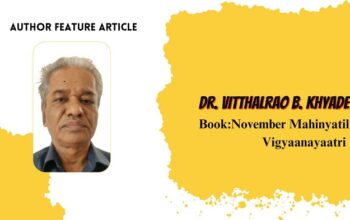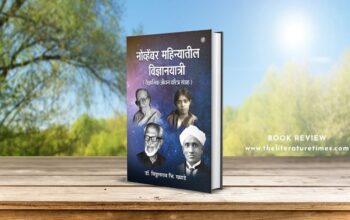In the fourth installment of Shubhan Dattanand Balvally’s ARIHANT series, ARIHANT REPROGRAMMED: MISSION MARTYRS, the stakes are raised to a whole new level, where history, science fiction, patriotism, and philosophical speculation collide in a daring and ambitious narrative. Blending cutting-edge technology with an emotionally charged retelling of India’s past, Balvally delivers a book that is as much a tribute to the sacrifices of India’s freedom fighters as it is a futuristic exploration of artificial intelligence, time travel, and geopolitical imagination.
The story picks up in a post-war India where peace has finally been restored, thanks to the heroic efforts of computer scientist Suraj Singhania and his AI-driven army—headed by the valiant Android leader ARIHANT and Gynoid commander AKSHITA. These bionic warriors, once used in an epic battle against the nefarious General Farrukh Musharraf and his BLACK DEVILS, are now fully integrated into India’s defense ecosystem. Under the watchful eyes of Prime Minister Rohan Azad and Defence Minister Vinay Deshmukh, the AI army patrols every inch of the country with mechanical precision, ensuring unparalleled national security. In a world that has embraced the synergy of human and machine, India becomes a beacon of technologically enhanced sovereignty.
Balvally’s vision of a hyper-advanced India doesn’t stop with android soldiers. Suraj’s laboratory becomes a cradle of innovation, producing microbots, nanobots, swarm robotics, and cutting-edge drones. This phase of exponential technological expansion is not merely decorative—it is the foundation for what becomes the novel’s central speculative thrust: time travel. Enter physicist Balram Nagpal and his cousin Samay Nagpal, a dual PhD in Physics and Astronomy, whose invention of a time machine unlocks a dramatic shift in narrative direction. The discovery of a twin Earth, lagging behind our own planet by three months in time, becomes the gateway to a mission unlike any other in Indian science fiction: to travel back to the British colonial era and rewrite history by saving India’s greatest martyrs from their tragic fates.
This premise alone is strikingly bold. Balvally is not merely interested in an action-packed narrative of gadgets and warfare; he is engaging in a form of speculative historical revisionism that touches on deeply sensitive national memories. By bringing the IRON Army into India’s colonial past, the novel dares to ask: what if the course of India’s independence movement could be altered through futuristic intervention? What if Bhagat Singh could be saved? What if the brutalities of Jallianwala Bagh or the betrayals of partition could be thwarted with the foresight of 21st-century minds and machines?
The novel’s action sequences are vivid, cinematic, and brimming with high-tech spectacle. Balvally writes with a kinetic energy that keeps the pace brisk and engaging. The combat scenes between AI warriors and British colonial forces are imaginative, if occasionally over-the-top, and the contrast between the disciplined logic of machines and the chaotic violence of human conflict is well-played. ARIHANT and AKSHITA, though machines, are endowed with distinct personalities and moral compasses, often reflecting a more principled stance than their human counterparts. This anthropomorphizing of AI serves a thematic purpose—highlighting how loyalty, sacrifice, and justice are not limited to flesh and blood.
Yet beneath the action and sci-fi sheen lies a deeper philosophical inquiry. MISSION MARTYRS is not content with simply rewriting history—it wrestles with the ethics of doing so. Can one truly alter the past without unraveling the future? Are historical martyrs diminished by being “saved,” or honored by being remembered? Does preventing the partition of India through futuristic interference strip the event of its complex socio-political underpinnings? These are weighty questions that Balvally wisely weaves into his narrative without becoming overly didactic. The characters, especially Suraj and Samay, frequently debate the consequences of their actions, adding layers of introspection to what could have been a straightforward alternate history.
The tone of the novel is unabashedly patriotic, but not blindly so. While the book reveres India’s martyrs and independence leaders, it does not shy away from acknowledging internal conflicts, ideological divides, and the realpolitik of colonial and post-colonial governance. The presence of fictional leaders like Rohan Azad and Vinay Deshmukh allows Balvally to create an idealized political environment in the present, against which the chaos and tragedy of colonial rule stand in sharp contrast. The novel’s patriotic core is reinforced through rousing dialogues, emotionally charged tributes, and vivid depictions of historical struggle—but it always leaves room for nuance, making it accessible to readers beyond nationalistic boundaries.
Structurally, the book moves between present-day India and its colonial past with relative ease, aided by well-timed transitions and a sense of narrative urgency. The twin Earth device, while scientifically implausible in conventional terms, is used cleverly to establish a fresh logic of time travel that allows characters to interact with the past without the usual paradoxes. Balvally doesn’t get bogged down in technobabble; instead, he uses sci-fi elements to service the plot and its emotional arcs. The idea of a three-month temporal lag offers just enough leeway for intervention without total disruption—an elegant workaround that facilitates the story’s central mission.
Character development, while secondary to the novel’s ideas and plot, is serviceable. Suraj remains the linchpin—a modern-day visionary whose moral clarity and scientific brilliance make him a likable hero. ARIHANT and AKSHITA, while technically machines, grow increasingly human through their actions and decisions, symbolizing a future where AI not only aids humanity but possibly understands it better than we understand ourselves. The Nagpal cousins, particularly Samay, provide the intellectual ballast for the story’s more speculative turns. Some secondary characters, especially historical figures, are portrayed with reverence but occasionally veer into caricature, which slightly diminishes their narrative depth.
The novel’s conclusion leaves room for future installments, suggesting that history’s grip is both tighter and more fragile than it seems. Whether or not Suraj and his team succeed in permanently averting partition is left partially unresolved—hinting at the complexity of real-world change, even within the realm of science fiction.
In sum, ARIHANT REPROGRAMMED (Part 4): MISSION MARTYRS is a bold, genre-defying blend of historical fiction, futuristic science, and national imagination. Shubhan Dattanand Balvally has written a novel that not only entertains with its action and high-concept thrills but also invites readers to reflect on the meaning of sacrifice, the ethics of intervention, and the ever-evolving relationship between technology and humanity. It’s an ambitious, thought-provoking addition to Indian science fiction literature—one that will appeal to fans of speculative history, military techno-thrillers, and patriotic sagas alike.



